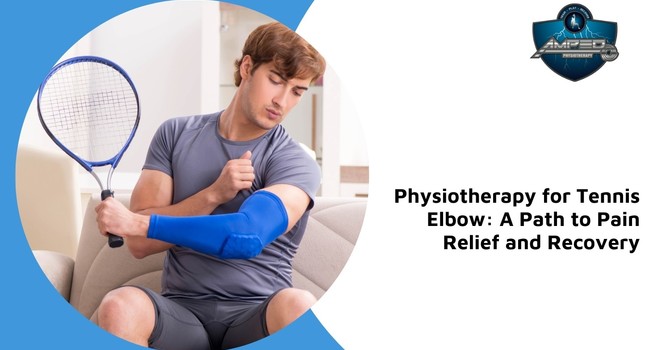Tennis elbow, a common condition affecting many individuals, can be particularly challenging due to its impact on daily activities and overall quality of life. Whether you are an avid tennis player or someone who engages in repetitive arm movements, understanding the causes, symptoms, and effective treatments for tennis elbow is crucial. This blog will explore how physiotherapy can help treat tennis elbow, specific techniques used in therapy, and what to expect during your recovery journey.
Tennis Elbow Explained
Tennis elbow, or lateral epicondylitis, is a condition characterized by pain and inflammation around the outside of the elbow. It typically results from overuse or repetitive stress on the forearm muscles and tendons that attach to the lateral epicondyle, a bony prominence on the outside of the elbow. Despite its name, tennis elbow is not limited to tennis players and can affect anyone who engages in activities that involve repetitive arm, elbow, or wrist movements.
Tennis elbow is commonly caused by repetitive motions that strain the forearm muscles and tendons. Activities such as using tools, painting, playing musical instruments, and engaging in sports like tennis or badminton can lead to this condition. Poor technique and inadequate equipment in sports can also contribute to the development of tennis elbow.
The primary symptom of tennis elbow is pain on the outside of the elbow, which may radiate down the forearm. This pain often worsens with activities that involve gripping, lifting, or twisting the forearm. Other symptoms include tenderness, stiffness, and weakness in the forearm and wrist.
Tennis elbow can affect anyone, but it is more common in individuals aged 30 to 50. Athletes, manual labourers, and individuals with hobbies or jobs that involve repetitive arm movements are at higher risk. Additionally, improper technique or equipment in sports and activities can increase the likelihood of developing tennis elbow.
Benefits of Physiotherapy for Tennis Elbow
Physiotherapy is a highly effective treatment approach for tennis elbow. It focuses on relieving pain, reducing inflammation, and restoring strength and function to the affected muscles and tendons. Here are the key benefits of physiotherapy for tennis elbow:
- Pain Relief: Physiotherapists use various techniques to reduce pain and inflammation. These methods help alleviate discomfort and promote healing.
- Restoring Range of Motion: Gentle stretching and mobilization exercises are designed to restore the normal range of motion in the elbow and wrist. These exercises help reduce stiffness and improve flexibility.
- Strengthening Muscles: Targeted strengthening exercises for the forearm, wrist, and hand muscles help build strength and support the injured area. Strengthening these muscles reduces the strain on the affected tendons and prevents further injury.
- Improving Function: Functional training focuses on improving daily activities and movements, ensuring individuals can return to their normal routines without pain or limitations.
- Preventing Recurrence: Physiotherapists provide education on proper techniques and ergonomics for daily activities and sports. This guidance helps prevent future episodes of tennis elbow and reduces the risk of recurrence.
Physiotherapy Techniques Used for Tennis Elbow
Physiotherapists employ a variety of techniques to treat tennis elbow, tailored to the individual’s specific condition and needs. Common techniques include:
- Manual Therapy: This involves hands-on techniques to mobilize and manipulate the elbow and wrist joints, improving mobility and reducing pain. It may include soft tissue massage to relieve muscle tension.
- Exercise Therapy: Customized exercise programs focus on stretching and strengthening the forearm, wrist, and hand muscles. Exercises such as wrist extensor stretches, forearm pronation and supination, and wrist flexor strengthening are commonly prescribed.
- Transcutaneous Electrical Nerve Stimulation (TENS): TENS therapy uses low-voltage electrical currents to relieve pain. Electrodes placed on the skin deliver electrical impulses that interfere with the transmission of pain signals, providing relief from tennis elbow discomfort.
- Neurodynamics Therapy: This approach focuses on improving the mobility and function of the nervous system. For tennis elbow, neurodynamics therapy involves specific movements and exercises to mobilize the nerves in the arm, reducing pain and improving function.
- Education and Self-Management: Physiotherapists provide guidance on proper techniques, equipment, and ergonomics to prevent further strain on the elbow. They may also suggest modifications to daily activities and exercises to manage symptoms effectively.
- Acupuncture: This treatment involves inserting fine needles into specific points on the body to relieve pain and promote healing. Acupuncture can help reduce pain and inflammation in the affected area, making it a beneficial addition to physiotherapy for tennis elbow.
How Long Does It Take to Recover from Tennis Elbow with Physiotherapy?
The recovery timeline for tennis elbow with physiotherapy can vary depending on the severity of the condition, the individual’s overall health, and adherence to the treatment plan. Generally, you may begin to notice improvements within a few weeks of starting physiotherapy. During the initial phase, the focus is on reducing pain and inflammation while maintaining muscle tone through gentle exercises and manual therapy techniques.
As treatment progresses, the physiotherapist will introduce more advanced exercises to strengthen the forearm muscles and improve flexibility. Consistent practice of these exercises, combined with regular therapy sessions, can lead to significant improvements in muscle strength and function.
Most individuals see substantial recovery within three to six months, although this can vary. Chronic cases may require a more extended treatment period, but with a structured physiotherapy program, even long-term tennis elbow can be effectively managed and improved.
Managing Tennis Elbow: At-Home Exercises
There are several exercises you can do at home to help manage and recover from tennis elbow. These exercises are designed to stretch and strengthen the forearm muscles, reduce pain, and improve flexibility. Here are some effective at-home exercises:
- Wrist Extensor Stretch: Hold your arm out straight in front of you with your palm facing down. Use your other hand to gently pull your fingers back towards your body until you feel a stretch in your forearm. Hold for 15-30 seconds and repeat 3 times.
- Wrist Flexor Stretch: Extend your arm in front of you with your palm facing up. With your other hand, gently pull your fingers back towards your body until you feel a stretch in the underside of your forearm. Hold for 15-30 seconds and repeat 3 times.
- Towel Twist: Hold a rolled-up towel with both hands. Twist the towel in opposite directions, as if wringing out water. Perform this exercise in both directions for 10-15 repetitions to strengthen the forearm muscles.
- Wrist Curls: Use a light dumbbell or a household item like a soup can. Sit with your forearm resting on a table or your thigh, palm facing up. Slowly curl the weight up towards your body, then lower it back down. Perform 10-15 repetitions.
- Reverse Wrist Curls: Similar to wrist curls, but this time with your palm facing down. Lift the weight upwards, then lower it back down. Perform 10-15 repetitions.
- Finger Extensions: Place a rubber band around your fingers and thumb. Open your hand against the resistance of the band, then close it. Repeat 10-15 times to strengthen the finger and forearm muscles.
Consistency is key with these exercises. Performing them regularly can help alleviate symptoms and prevent future occurrences of tennis elbow.
Preventing Tennis Elbow Recurrence: Recommended Lifestyle Changes
Preventing tennis elbow from recurring involves making several lifestyle changes and adjustments to reduce strain on the forearm muscles and tendons:
- Proper Technique: Ensure you are using the correct technique in activities that involve repetitive arm movements, such as sports, typing, or using tools. Consider getting coaching or training to improve your form.
- Ergonomic Adjustments: Make ergonomic adjustments at work and home to reduce strain on your arms. This might include using an ergonomic keyboard, adjusting your desk height, or using tools with cushioned grips.
- Warm-Up and Stretching: Always warm up and stretch before engaging in activities that involve your forearm muscles. This helps prepare the muscles and tendons for the workload and reduces the risk of injury.
- Regular Breaks: Take regular breaks during repetitive tasks to rest and stretch your muscles. This helps prevent overuse and reduces the risk of developing tennis elbow.
- Strengthening Exercises: Incorporate forearm strengthening exercises into your regular fitness routine to build muscle endurance and support the tendons.
- Proper Footwear: Wearing supportive shoes can improve your overall posture and biomechanics, reducing the strain on your upper body and arms.
- Weight Management: Maintain a healthy weight to reduce the overall stress on your body, including your arms and elbows.
Physiotherapy Sessions for Tennis Elbow: What to Expect
During a physiotherapy session for tennis elbow, you can expect a comprehensive and personalized approach to your treatment. Here’s what typically happens:
- Initial Assessment: The physiotherapist will start with a thorough assessment to understand your medical history, symptoms, and the severity of your condition. They may ask about your daily activities, work habits, and any specific triggers for your pain.
- Physical Examination: The physiotherapist will conduct a physical examination to assess your range of motion, strength, and areas of tenderness in your elbow and forearm. This helps them identify the specific muscles and tendons affected.
- Treatment Plan: Based on the assessment, the physiotherapist will develop a personalized treatment plan tailored to your needs. This plan may include a combination of manual therapy, exercises, and other modalities to address your symptoms.
- Education and Advice: The physiotherapist will provide education on proper techniques, ergonomics, and self-management strategies to prevent future episodes of tennis elbow. They may also suggest modifications to your daily activities to reduce strain on your forearm muscles.
- Progress Monitoring: Throughout your treatment, the physiotherapist will monitor your progress and adjust the treatment plan as needed to ensure optimal recovery.
Get Back to Your Best Today
Physiotherapy is a highly effective treatment approach for tennis elbow, offering pain relief, restoring function, and preventing recurrence. By understanding the causes, symptoms, and treatment options for tennis elbow, individuals can take proactive steps to manage and overcome this condition.
If you are experiencing symptoms of tennis elbow, don’t wait to seek help. At Amped Physiotherapy in Ottawa, our team of physiotherapists is dedicated to providing personalized care to help you recover and regain full function. Contact us today to schedule an appointment and we’ll help you get back to doing the things you love with confidence and ease.










